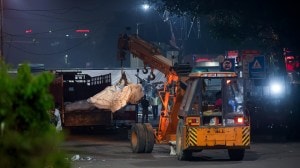No respite from blanket of haze for Delhi-NCR; AQI ‘severe’ for third day in row
The CPCB classifies AQI in the ‘Severe’ category when it is above 400. Such poor levels of air quality affect even healthy people and “seriously impact those with existing diseases", according to the pollution watchdog.
 Haze engulfs Jama Masjid in Old Delhi on Thursday. (Abhinav Saha)
Haze engulfs Jama Masjid in Old Delhi on Thursday. (Abhinav Saha)With no respite in sight, a blanket of haze continued to engulf Delhi-NCR on Thursday with the air quality index (AQI) in the ‘Severe’ category for the third day in a row. The average AQI index was reported at 404, only a few notches below Wednesday’s 418, as per data by the Central Pollution Control Board (CPCB).
The CPCB classifies AQI in the ‘Severe’ category when it is above 400. Such poor levels of air quality affect even healthy people and “seriously impact those with existing diseases”, according to the pollution watchdog.
In Noida, the AQI at 389 was in the ‘Very Poor’ category Similarly, Greater Noida reported AQI at 377, Ghaziabad at 370 and Gurgaon at 300. There is no relief expected anytime soon in Delhi-NCR as the Indian Institute of Tropical Meteorology has forecast the air quality to remain in the ‘Severe’ to ‘Very Poor’ range in the coming days.
Meanwhile, the Deputy Commissioners of Gurgaon and Faridabad on Thursday ordered that all schools in the respective districts conduct classes up to Class 5 in hybrid mode in the wake of the ‘very poor’ air quality and Stage III of the Graded Response Action Plan (GRAP).
This comes two days after Delhi implemented similar measures as the Commission for Air Quality Management in the National Capital Region and Adjoining Areas enforced restrictions under GRAP III.
During this time of the season, low temperatures combined with calm wind conditions trap the pollutants close to the surface. The smoke transported from crop residue burning in neighbouring states of Punjab, Haryana, and Uttar Pradesh adds to the already high baseline pollution in Delhi. This is further worsened by vehicular emissions, dust from construction activities, and pollution from industries, as per experts. Notably, the air quality index in the Capital has not gone below 50 in the last two years.
On Thursday, the stubble burning contribution, while lower than the previous day, remained significant at 12.04%. The contribution of farm fires to Delhi’s air pollution was at its highest this season at 22.47% on Wednesday. The transport sector emissions at 19.82% contributed the highest to the capital’s PM2.5 load, as per the Decision Support System (DSS). The residential sector emissions were reported at 4.83% and the construction and demolition waste at 2.92%.
According to the Indian Agricultural Research Institute, “13,793 burning events have been detected in six states between September 15 and November 12, which are distributed as 4,662, 464, 2,490, 4, 1,736 and 4,437 in Punjab, Haryana, UP, Delhi, Rajasthan and MP, respectively.”
As the stubble burning activity picks up, a nip in temperatures for the last four days has worsened the situation in Delhi-NCR. As per the India Meteorological Department (IMD), the minimum temperature was recorded at 10.6 degrees Celsius, almost three notches below the season’s normal on Thursday.
The day’s temperature settled at 26.3 degrees Celsius, which was near normal. The IMD has forecast below-normal temperatures this week. As a result, fog conditions are expected to intensify.






